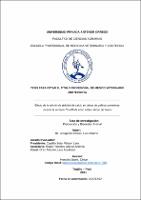Efecto de la adición de pidolato de calcio en dietas de gallinas ponedoras durante la semana 70 a 80 de edad sobre calidad de huevo

Ver/
Descargar
(application/pdf: 917.7Kb)
(application/pdf: 917.7Kb)
Fecha
2021Autor(es)
Liviapoma Flores, Luis Alberto
Metadatos
Mostrar el registro completo del ítemResumen
El objetivo de la investigación fue evaluar el efecto de la adición de
pidolato de calcio en dietas de gallinas ponedoras durante la semana 70
hasta la 80 de edad sobre la calidad de huevo. Se utilizaron 1120 gallinas
ponedoras de la línea Hy-line Brown, las cuales fueron distribuidas a través
de un diseño completamente al azar en cuatro tratamientos: DB (dieta base
sin adición de pidolato), DB15 (dieta base con adición de pidolato a
0.015%), DB30 (dieta base con adición de pidolato a 0.030%), DB45 (dieta
base con adición de pidolato a 0.045%) con diez repeticiones para cada
tratamiento y 28 aves por unidad experimental. Se evaluaron peso de
huevo (g), altura de albumina (mm), unidades haugh (UH), resistencia a la
ruptura (kgf) y grosor de cáscara (mm) mediante el equipo DET 6000. Para
el análisis estadístico se empleó análisis de variación ANOVA, y la prueba
de Tukey para comparar diferencias entre los tratamientos (P<0.05). Las
aves que consumieron dietas con inclusión de 0.015, 0.030 y 0.045% de
pidolato de calcio presentaron mayor peso de huevo, altura de albumina,
unidades haugh, resistencia a la ruptura y grosor de cáscara en
comparación a las que no recibieron el producto (P<0.05); no obstante, no
existió diferencia estadística entre los niveles de inclusión. Concluimos que
el pidolato de calcio en dieta de gallinas ponedoras, tuvo un efecto positivo
sobre los parámetros de calidad externa e interna del huevo: peso de
huevo, altura de albumina, unidades haugh, resistencia a la ruptura y grosor
de cascara The objective of the research was to evaluate the effect of the
addition of calcium pidolate in diets of laying hens during the 70 to 80 week
of age on egg quality. For which 1120 laying hens of the Hy-Line Brown line,
from 70 to 80 weeks of age were used, which were distributed with a
completely randomized design divided into four treatments: DB (Base diet
without addition calcium pidolate), DB15 (Base diet with calcium pidolate
addition to 0.015%), DB30 (Base diet with addition calcium pidolate to
0.030%), DB45 (Base diet with addition calcium pidolate to 0.045%) with
ten repetitions for each treatment, having as an experimental unit of seven
hens. Evaluating productive parameters: egg weight (g), albumin height
(mm), haugh units (UH), breaking strength (kgf) and shell thickness (mm),
egg production (%) using the DET 6000 equipment. For the statistical
analysis ANOVA was used using the statistical program Infostat and the
Tukey test to compare differences between treatments (P<0.05). The birds
that consumed diets with inclusion of 0.015, 0.030 and 0.045% calcium
pidolate presented higher egg weight, albumin height, haugh units,
resistance to rupture and shell thickness compared to those that did not
receive the product (P <0.05), however, there was no statistical difference
between the inclusion levels. We conclude that calcium pidolate in the diet
of laying hens had a positive effect on the external and internal quality
parameters of the egg: egg weight, albumin height, haugh units, resistance
to rupture and shell thickness
Colecciones
- Veterinaria y Zootecnia [197]

